American Views on Face Masks and Strategies for Cooperation
.png)
Zencity
The Platform for Community Trust
Masks are here to stay. Therefore, understanding what your residents have to say about them is critical.
What is the Zencity data telling us?
Mask-related discourse generated nearly 10 million online resident interactions since the beginning of May across the Zencity Network of 150 US cities and counties. A spike in conversation took place during the second half of June, as reopening plans and state and local mask mandates came into effect. In the Mountain Plains Region, this accounted for nearly 25% of the total resident discourse. Residents mostly discuss masks in the context of retail and restaurants, followed by conversations related to events and open spaces.
Diving into city-specific data reveals the different concerns residents are voicing when opposing masks regulations, these include – infringement of rights, medical exemptions and lack of evidence that masks help slow and prevent the spread of COVID-19. Zencity’s data also shows that while enforcement can be a sensitive issue, local authorities can increase positive sentiment and compliance by sharing short, informative, and creative messaging about masks, supported by data and scientific evidence of their effectiveness.
Almost 6 months into the pandemic, Americans are still divided on wearing masks. Despite recent research findings supporting the effectiveness of masks and the CDC’s recommendations that everyone wears a face mask in public, the lack of clear federal guidance leaves state and local government leaders with the challenge of setting their own policies. As a result of that, they are also challenged with their residents’ conflicting opinions on the matter.
Zencity analyzed over 9.7 million online interactions from over 150 cities and counties across the US to understand what Americans are actually saying about face masks. We also studied and analyzed official city communications and campaigns, to highlight best practices when it comes to encouraging residents to wear face covers. By understanding how residents are reacting to different face mask mandates, other local government leaders will be able to reach out to their communities in a way that resonates with them and increases compliance and cooperation.
Mask Mandates Escalate Online Reactions
As of today, policies regarding mask-wearing vary from state to state. In California, New York, Nevada, and North Carolina, rules requiring masks are in effect, but in states such as Arizona and Florida, there has been a hesitance to issue a state mandate, leading mayors and local governments to impose their own local regulations.
This disparity is causing a spike in online public discourse on the topic of face masks, as more and more Americans are taking to social media platforms to voice their opinions, concerns, and confusion. Zencity’s data detected over 9.7 million online interactions about face masks that have occurred during May and June. Interestingly, during the second half of June with reopening accelerated and as several states decided to delegate mandate-setting to local governments, public online discourse regarding face masks increased by over 300%.
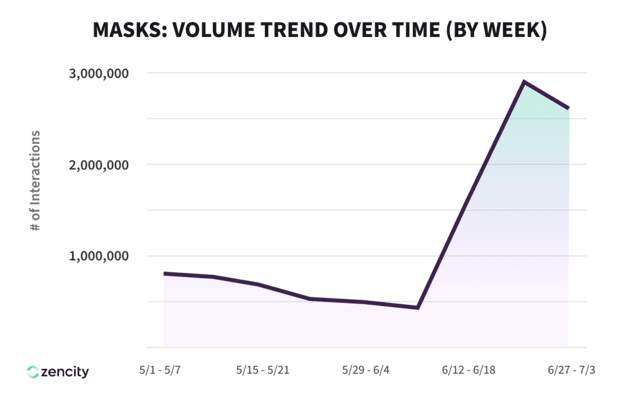
This spike in Americans’ concern with face masks differs between ICMA regions. Interestingly, there is no clear correlation between the volume of online conversations regarding face coverings and the states in which they are required. For example, though only 3 out of the 14 Mountain Plains states require face masks, this region saw the highest increase in related discourse. In addition, there is no correlation between the discourse volume and the number of COVID-19 cases in each region. This suggests that not only regulation and enforcement are driving the public discourse, but also the lack thereof.
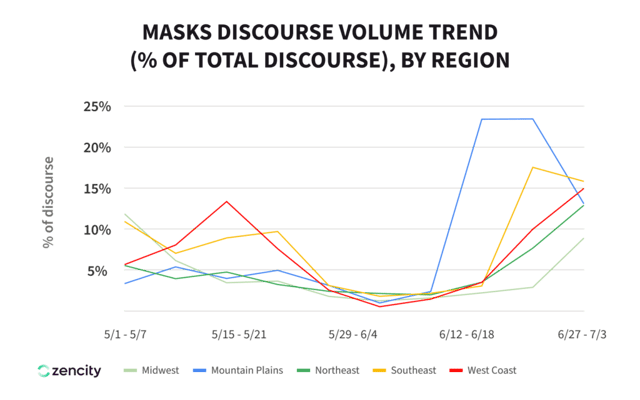
Residents are concerned about Local Businesses
When diving into the data we note that discourse surrounding face masks focuses primarily on businesses, with over 45% of interactions representing general comments about the local economy. A further breakdown by topic reveals that residents are talking most about retail stores and shops, followed closely by restaurants, events & entertainment and parks & recreation.
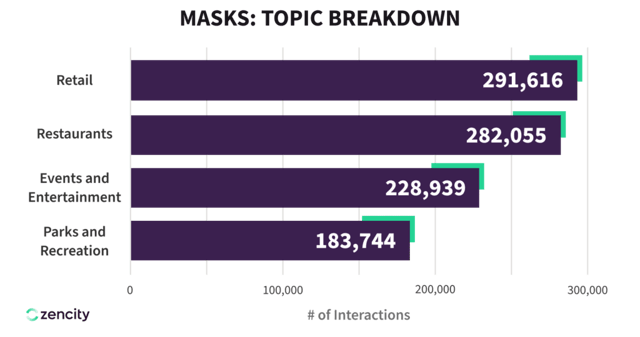
Another common subject of interest is enforcement and the challenges businesses face in making sure that both employees and customers comply with face mask guidelines. For example, our data reveals that in one of Texas’s largest cities, 3,606 online interactions were related to enforcement, including comments that the burden of policing customers is a responsibility that should fall to the government and not business owners themselves. This insight highlighted the need to communicate more about the city’s approach to enforcing mask-wearing and what resources are available to businesses.
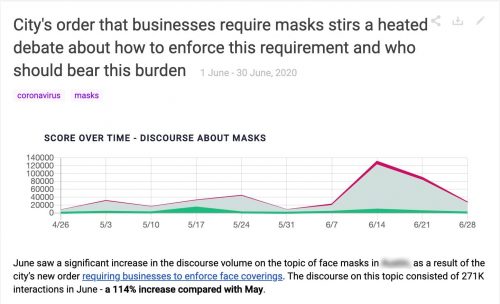
While some Americans consider face masks as the primary defense against COVID-19, others consider it a symbol of government intervention and a violation of their constitutional rights. In one Florida city, a Zencity analysis revealed that 61% of resident feedback was in support of face covering and 39% opposed. Most of those against it stated they would not be wearing masks, claiming it is unconstitutional and not the government’s place to decide. Others simply argued that masks have not yet proven to be effective – leading the city to understand it needs to better communicate the scientific findings about the effectiveness of face masks.
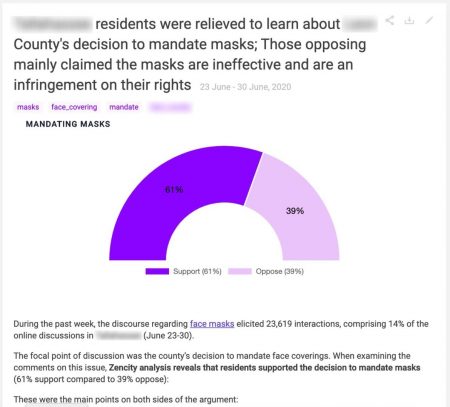
Other recurring concerns that US residents have expressed are the potential health risks of wearing a mask and medical exemptions for those who can not wear a mask at all. For example, the most common concern in one North Carolina city is that breathing in CO2 for extended periods of time is harmful. Residents also discussed how those suffering from anxiety disorders, as well as asthma and COPD, will find it difficult to comply with face-covering orders. This data served as an indication to the city that their communications about masks need to directly address these concerns.
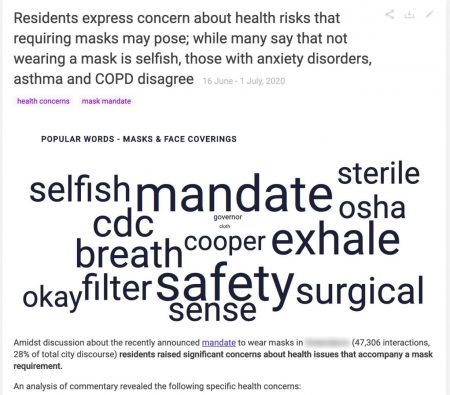
Another interesting example is from one of our California cities where the colliding crises of COVID-19 and the George Floyd protests shifted residents’ main arguments about masks over time. As the insight below indicates, discourse with tones of solidarity about masks being a worthwhile, minor inconvenience for the safety of others gained some upward traction – from 10% in May to 12% in June. In comparison, claims about masks being ineffective and unconstitutional diminished. By using this comparison, the city was able to better understand the drivers of conversations and address them accordingly through communication and policy.
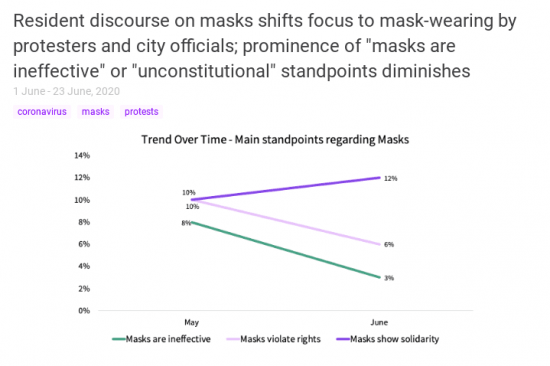
Interested to learn what residents are saying about reopening?
Check out our latest data report to understand residents’ attitudes towards the reopening of certain industries and business sectors.
Unmasking the Power of Communications
Getting your residents to actually wear the masks is tricky and is in part a behavioral issue. In times of heightened tensions between residents and police, mask enforcement is even more sensitive and challenging. Cities and counties are, therefore, turning to the power of good communications in an attempt to make masks a social norm and are using social enforcement as the means to keep that norm in place.
Short, visual, and concise messaging is key here. It is crucial for local governments to create clear messaging on the subject of masks by providing information and statistics, sharing constant findings from recent research, issuing specific guidelines or recommendations, and going about it in creative ways. To help cities and counties effectively encourage face covering, we’ve gathered a few exemplary posts by local governments and highlighted best practices for messaging on masks.
1. Keep. It. Short.
When it comes to communications, shorter is better. One of the most popular tweets by Mayor Lori Lightfoot of Chicago, IL, simply read, “Wear. Your. Masks. People”, while another successful tweet said, “Hi. Wearing a mask isn’t about controlling your freedom. It’s about controlling the spread of COVID-19. #WearAMask”. The City of Pittsburgh, PA is also keeping things short and simple, writing: “It’s simple. Wear a mask, #Pittsburgh”.

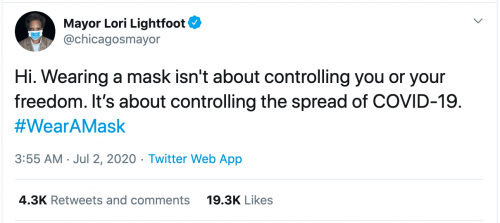

2. Let's Talk Numbers
Sharing statistics and the number of new cases in relevant regions can often speak louder than any catchy slogan or reasonable explanation. One of Bill Peduto’s, the Mayor of Pittsburgh, PA, most popular tweets opens with the number of new COVID-19 cases in their county. Similarly, Chicago, IL shared a graph to show exactly how face coverings and social distancing have slowed the spread of the virus in the city.
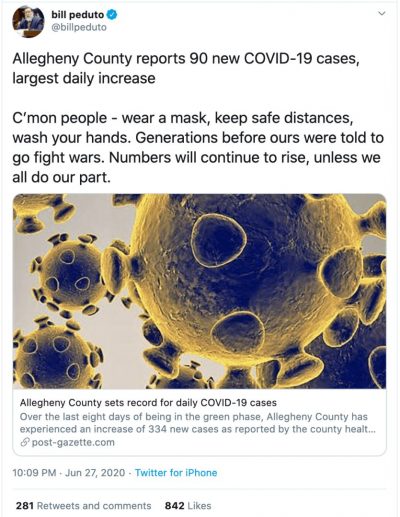
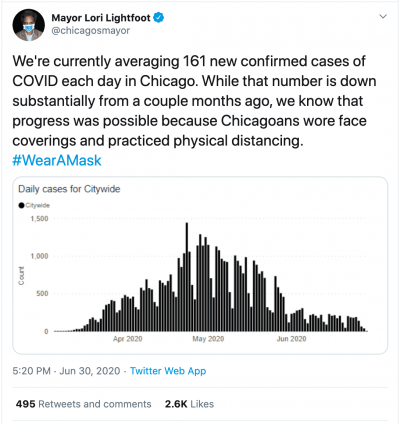
3. Be Informative
Media outlets and social media, in particular, are overwhelming residents with opinions, hashtags, and conflicting messages. Residents are looking to official channels, owned by the different city departments, for direct information and reliable updates that are becoming harder to find. The City of Spokane, WA directly tackled this problem by sharing an informative brochure on the do’s and don’ts of face covering. Another great example comes from The City of Carlsbad, CA who shared a simple infographic on how face covering affects the risk of spread.
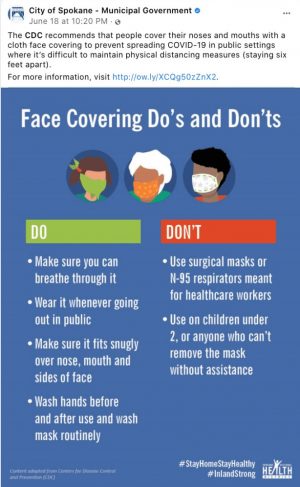
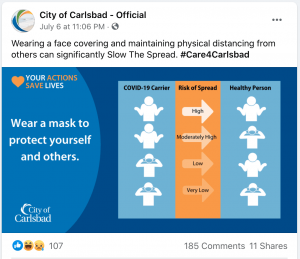
4. Get Creative. Get Visual.
Out-of-the-box initiatives and great visuals are always a great way to catch your residents’ attention and make sure your message remains memorable. The City of Memphis, TN created a brilliant and witty campaign comparing wearing a mask to wearing underwear – “not always required, but definitely encouraged”. In Aurora, IL the city created Aurora Pride face masks just in time for the local pride festival.
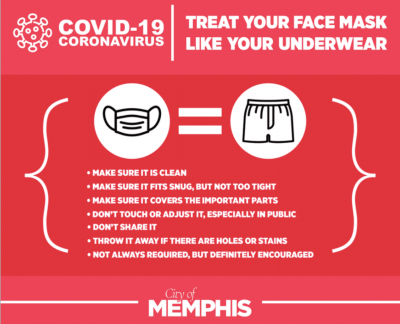
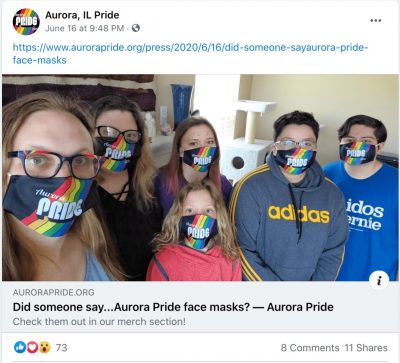
Discover our COVID-19 and Reopening Solutions to learn how 150+ local authorities are using Zencity as part of their COVID-19 response toolkit in order to prioritize resources, shape policies, track performance, and better connect with their communities.
%20copy-1.png?width=544&height=120&name=Logo_black%20(1)%20copy-1.png)



